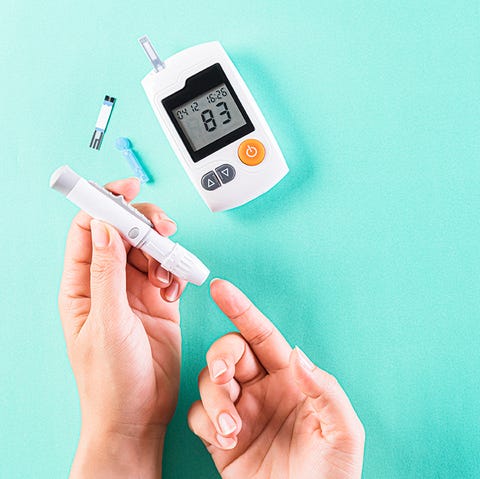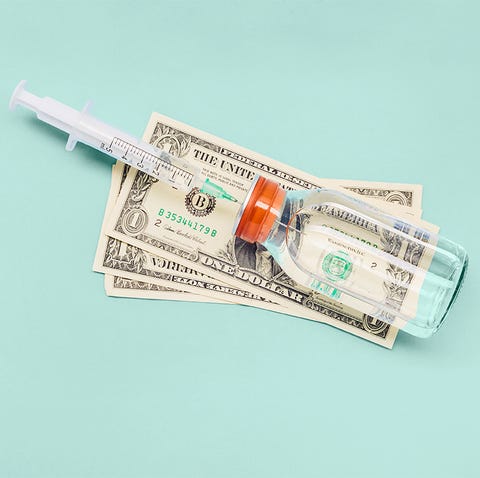From goodhousekeeping.com
By Emily Goldman
"Living with this disease isn't easy, but it revealed a resilience I didn't know I had and taught me the true meaning of empathy."
My mouth felt as if it were full of cotton balls, and my head was pounding. "You can't leave until you give yourself an injection," the doctor told me. I stared at her with equal parts disbelief, defiance and horror. How could I, who dreaded even routine blood draws, stab myself with a needle, even if that injection would save my life?
That day, after a year of looking for the cause of my near-constant headaches, unquenchable thirst and overall exhaustion, I became, at age 20, one of the nearly 1.6 million people living with type 1 diabetes in the United States and one of 64,000 people diagnosed each year.
Type 1 diabetes is an autoimmune disease that occurs when a person's pancreas stops producing insulin, the hormone that controls blood sugar levels. Specifically, this type of diabetes develops when the insulin-producing pancreatic beta cells are destroyed by the body's immune system; what causes the body to attack itself this way is still being researched. (Type 2 diabetes, the most common type, occurs when the body doesn't properly use the insulin it makes.)
As I sat in that doctor's office, the world around me seemed to stop. While the words left her mouth, with my mother silently crying beside me, I found my resolve to give myself a shot of insulin shrinking to the size of a needle tip. But what choice did I have?
Eight years later, I've come a long way: I've mostly overcome my fear of needles — pricking your fingers at least twice a day, every day, will do that! But I've also realized that there's so much more that goes into keeping myself alive. People living with type 1 diabetes make an estimated 180 decisions per day about management of the disease in addition to doing everything else in their lives. Those choices and responsibilities begin as soon as I open my eyes each day.
"I've come to terms with the fact that Type 1 diabetes is a part of my life."
A Day in My Life
I start each morning by checking two devices, an insulin pump and a continuous glucose monitor (CGM), that are attached to my body. I'm privileged to be able to afford these tools— many people in the U.S. can't.
The pump holds the insulin I'll need for three to four days; it administers a programmed dose of the lifesaving liquid every hour as well as the additional insulin I need when I eat. Unlike the bodies of people who don't have diabetes, mine does not naturally produce insulin, the hormone that allows glucose to enter the cells to provide energy. I change out of the pump every few days.
The CGM, a device about the size of a tube of lipstick that I place on my stomach and change every 10 days, measures glucose levels via a thin wire that sits between the layers of the skin. Every five minutes it transmits a reading to my cell phone via Bluetooth, so I can see my blood sugar level in real time. The insulin pump and the CGM connect through and app, talking to each other through what's called a closed-loop system, to keep me alive.
Each morning I wake up and prick my finger to check that my CGM is reading accurately. Next, I open my insulin pump app on my phone and type in a carbohydrate estimate for my breakfast. My pump then calculates how much insulin I need and administers it through a tiny tube inside the pump called a cannula. But food isn't the only thing that affects my insulin levels—stress, exercise, menstrual cycle, dehydration and even a cold can have an impact on my blood sugar. Any sickness— especially COVID-19 — could send my body into a period of greater resistance or sensitivity to insulin.

GETTY IMAGES
I check my blood sugar frequently, doing finger pricks twice a day and looking at CGM readings on my phone about 10 times a day. I check based on how I feel, whether I'm eating and my activity levels — all of which vary hour by hour.
After breakfast, I head to work, which these days often means signing in on my laptop. Before the pandemic, I'd always have to factor in my walk to the subway station (and eat something sweet if my blood sugar was going low), silence my phone if a low- or high-glucose alert sounded during a meeting (sometimes I'd have to excuse myself to quickly eat a sugary snack then too) and/or scarf down a piece of candy before running to the subway to go home. Now, on days when I do go to the office, I make sure my co-workers know what to do in case I have a diabetic emergency, which makes a lovely first impression: "Hi, my name is Emily, and I'm diabetic — please inject me using this intimidating syringe of glucose if I pass out!"
Once I get home, I often have to eat a sugary snack again, as my blood sugar tends to drop from all the walking, and then I give myself insulin to cover the carbohydrates that usually are part of my dinner (generally a well-balanced plate of chicken, a low-carb veg like broccoli and a starch like couscous) and fight the urge to snack for the rest of the night. If I eat too late and don't give myself the right amount of insulin, I'll either have to drink a ton of water before bed (to flush out the glucose) or, more often, snack on some glucose tabs or gummy candies before I fall asleep because I gave myself more insulin than I needed to cover the dinner or dessert I ate. Naturally my blood sugar always seems to drop right after I brush my teeth!
For the most part, I've adjusted to my daily schedule. But one thing I truly miss about my life before diabetes is spontaneity. Every walk, meal and outing now needs to be planned to some degree. Gone are the days when I would order sweet-and-sour chicken and the only repercussion would be a bit of indigestion. Now, for stable blood sugars, I usually have to "prebolus," which is essentially giving myself insulin and letting it marinate for about 10 to 15 minutes, so it has time to work before I eat carbohydrates. Thrilling, I know.
The timing can be tricky. If I'm at a restaurant, for instance, and the food takes a lot longer to come than I've anticipated, the situation could become serious—fast. Since my body doesn't produce its own insulin or glucose, it can't regulate my blood sugar. If I give myself insulin and the food doesn't come soon enough afterward, I could experience hypoglycaemia (low blood sugar), which could cause confusion, lack of coordination and seizure in rare cases if left untreated. If I don't give myself enough insulin, I could ultimately go into diabetic ketoacidosis (DKA), a condition in which there is not enough insulin in the blood and the body begins to break down fat as fuel. Like many things in life, it's all about balance.

GETTY IMAGES
The High Cost of Care
Since I rely on medication to keep me alive every hour of every day and will for the rest of my life, living isn’t cheap for me — especially with insulin prices at a record high. Without insurance, one vial of insulin is around $275. I use anywhere from one to three vials — costing up to $900 before insurance — a month. But I’m lucky: Americans who don’t have medical insurance, or who have plans that cover just the bare minimum, often must choose between groceries and insulin. Paloma Kemak, a type 1 diabetic known as glitterglucose on Instagram, had to seek insulin outside the U.S. a number of times. “My insurance — as my doctor said, ‘if you can even call it insurance’— didn’t cover my insulin,” she says. “I was going through a divorce, dealing with insurance, but seeing the insulin supply in my fridge dwindle. Since I live in Arizona, Mexico isn’t too far, so I made the drive. $300-plus vs. $40? Yes, please.”
According to the journal article “Economic Costs of Diabetes in the U.S. in 2017,” people with diabetes incurred medical costs 2.3 times as high as those without the disease did that year. On average, they spent around $16,750 on medical bills — and that’s just an average. For those who are insulin dependent (as are all type 1 diabetics and some type 2’s), the price is likely much higher. According to the Health Care Cost Institute, in 2016 individuals with type 1 diabetes spent an average of $5,705 on insulin. That doesn’t include supplies like blood sugar test strips, oral medications and more.
Thankfully, the U.S. recently introduced legislation that, if passed, would help mitigate costs for all insured diabetics who use insulin. But until there’s a price cap on insulin for everyone, not just the insured, people will continue to ration the drug, and some will even die because of that.
My Surprising Strength
Looking back at the days just after my diagnosis, I can’t help but be in awe of myself. I moved 1,000 miles away from home, faced my fear of needles head-on and dealt with highs and lows — of both my blood sugar and my emotions. But it’s easy to see the toll this disease has taken on my body: Just look at my scars from past insulin pump sites, my callused fingers from countless finger pricks and the exhaustion from overall lack of sleep (high and low blood sugars don’t happen just during the day).
The disease can be overwhelming, but I’m no longer consumed by it. I’ve come to terms with the fact that my diabetes isn’t going away. Besides, it has brought me so much, taught me so much. Not only have I made many friends in the diabetes community, but I’ve learned that whether it’s a fear of needles or a big medical bill, you never know what battle another person is facing.
https://www.goodhousekeeping.com/health/a41695072/living-with-type-1-diabetes-personal-experience/


No comments:
Post a Comment